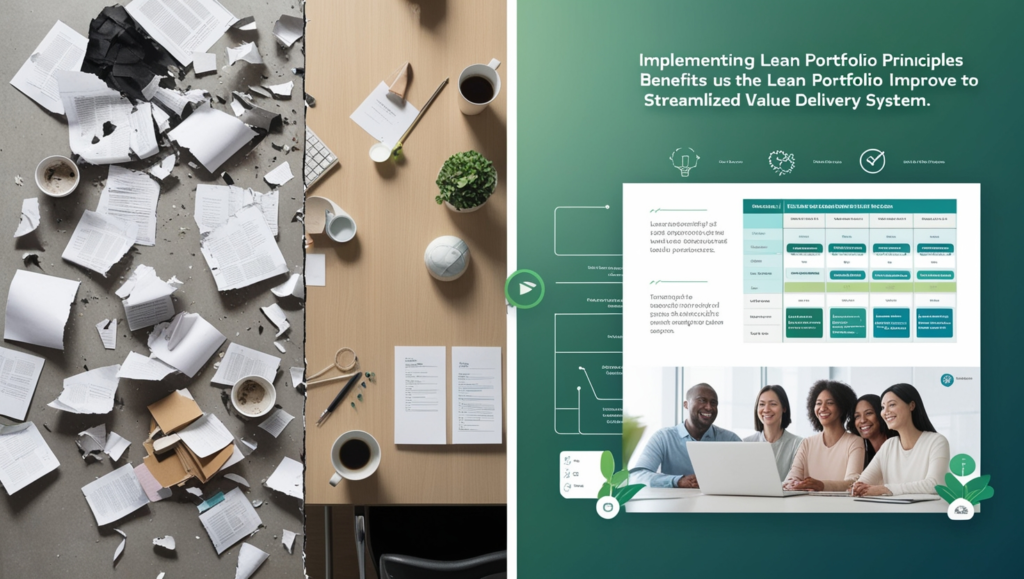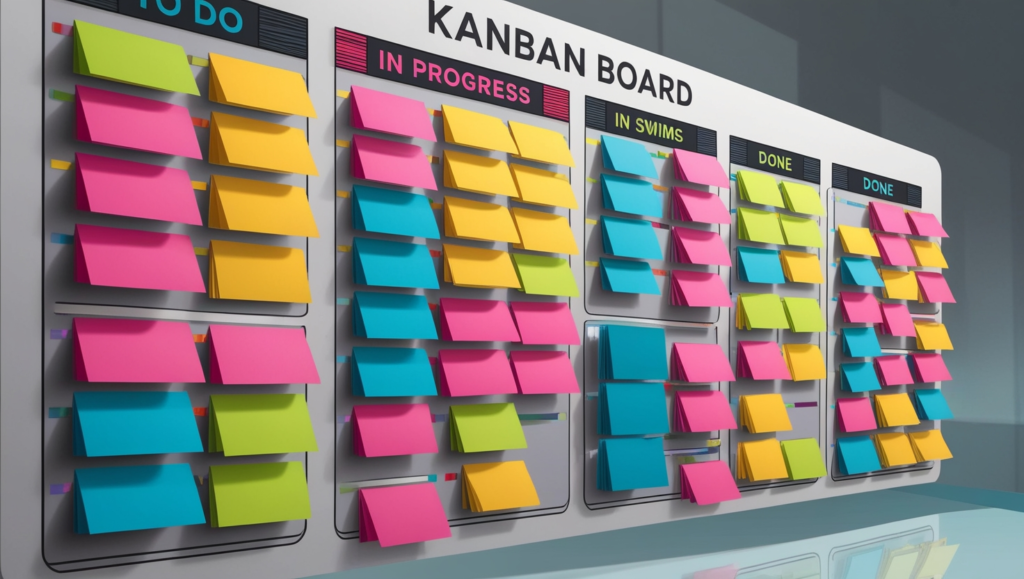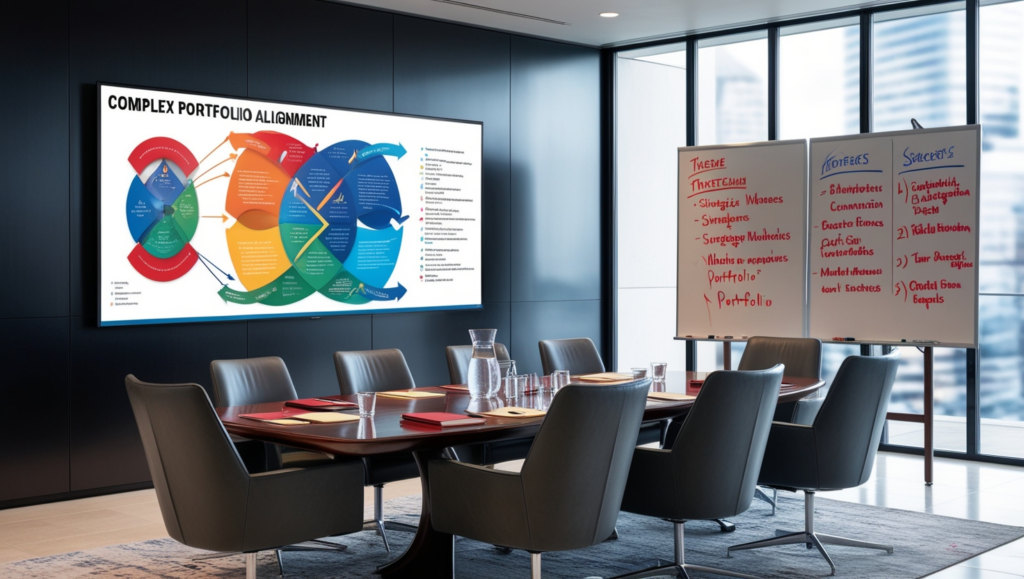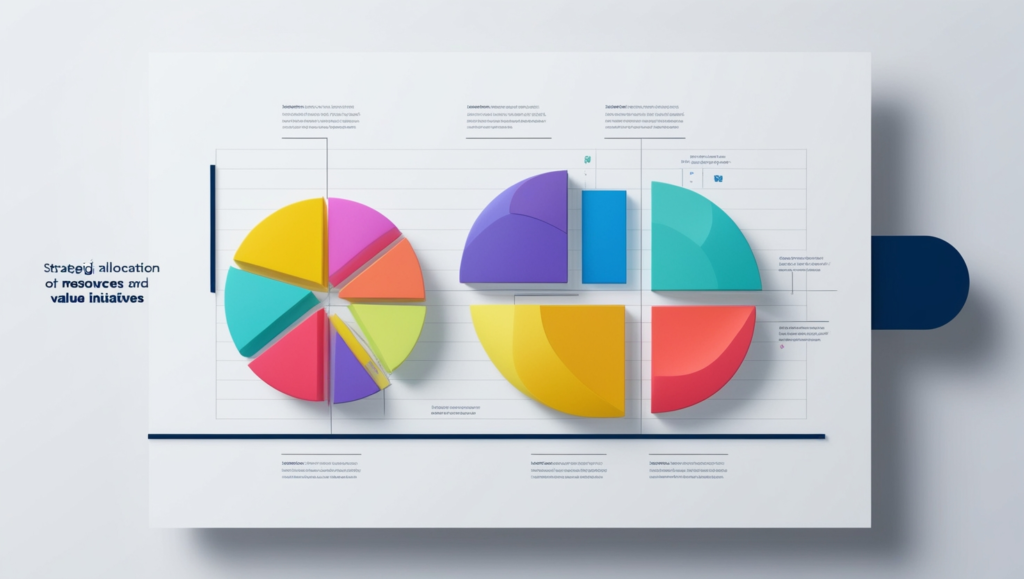Key Principles of Lean Portfolio Management
Lean portfolio management (LPM) is a strategic approach designed to maximize value delivery while minimizing waste. By focusing on agility, transparency, and customer-centric decision-making, LPM ensures that organizations prioritize initiatives that drive the most value. It enables companies to navigate complex and dynamic environments by aligning their portfolio with strategic objectives, empowering teams, and continuously improving processes. For more insights on optimizing workflows, explore Portfolio Management Schemes (PMS). Below are the key principles that underpin lean portfolio management.
Value Stream Mapping
One of the core principles of lean portfolio management is value stream mapping. This practice involves visualizing the entire flow of value within an organization, from idea conception to final delivery. By mapping out these value streams, companies can better understand how work progresses and where inefficiencies or bottlenecks occur. Identifying these obstacles is crucial to improving processes and reducing waste. Once the value stream is clear, organizations can streamline workflows, ensuring that resources are allocated effectively and only the highest-value initiatives are pursued. This level of transparency makes it easier to spot areas for improvement and aligns teams around common goals. For a deeper dive into optimizing work processes, see our guide on streamlining workflows.
Prioritization
Effective prioritization is at the heart of lean portfolio management. With limited resources, it is essential to focus efforts on initiatives that bring the greatest value. Techniques like Kanban and prioritization matrices help teams assess and select the most impactful projects. Kanban boards, for example, provide a visual representation of work, allowing teams to track progress and identify bottlenecks. By continuously reassessing priorities, organizations can ensure that they are working on the right initiatives at the right time. This approach fosters flexibility, allowing for quick adjustments when market conditions or customer needs change. For more on using Kanban for effective project management, check out our Kanban guide.
Continuous Delivery
Another key principle of lean portfolio management is continuous delivery. This approach emphasizes the need for rapid, incremental delivery of value. Practices like DevOps and Continuous Integration/Continuous Delivery (CI/CD) enable teams to deploy updates and features frequently, minimizing the time between development and customer feedback. By adopting these practices, organizations can create a continuous cycle of improvement. Teams are able to release smaller, more manageable updates that can be tested, refined, and deployed quickly. This reduces the risks associated with large-scale releases and ensures that value is delivered to customers faster. Continuous delivery also supports innovation, as it allows organizations to experiment with new ideas and rapidly adjust based on real-world feedback.
Customer Focus
A strong customer focus is another pillar of lean portfolio management. It ensures that decisions are aligned with customer needs and market demands. In a lean portfolio management framework, initiatives are prioritized based on their ability to meet customer expectations and provide tangible value. By staying in tune with customer feedback, organizations can adjust their strategies to address emerging trends and pain points. This approach helps businesses stay competitive and relevant in their industries. It also promotes a culture of customer-centricity across all levels of the organization, encouraging teams to constantly consider how their work impacts the customer experience. For more on enhancing customer experience, check out our customer feedback strategies.
Team Empowerment
Lean portfolio management emphasizes the importance of empowering teams to make decisions and solve problems. Instead of relying on top-down decision-making, LPM encourages a decentralized approach where teams are trusted with the autonomy to manage their own work. Empowering teams boosts morale and productivity, as individuals feel more invested in the outcomes of their projects. It also fosters innovation, as teams are given the freedom to experiment and find solutions that work best for them. When teams are trusted to make decisions, they can respond more quickly to changes and obstacles, enabling the organization to maintain its agility and speed.
Transparency
Transparency is another essential principle of lean portfolio management. Clear visibility into project progress, resource allocation, and performance metrics is crucial for making informed decisions. Visual tools like Kanban boards and dashboards help keep everyone on the same page. Regular communication across teams ensures that everyone has access to the information they need to perform effectively. By maintaining transparency, organizations can ensure that resources are being used efficiently and that there are no surprises regarding project timelines or deliverables. This open communication also fosters accountability, as teams and individuals are aware of their responsibilities and the impact of their work on the broader organizational goals.
Continuous Improvement
Lastly, continuous improvement is a fundamental aspect of lean portfolio management. The lean methodology encourages organizations to constantly evaluate and refine their processes. Regular retrospectives and feedback loops help teams identify areas for improvement and implement changes incrementally. This iterative approach ensures that organizations are always learning and evolving. By continuously improving, businesses can adapt to changing conditions and maintain a competitive edge. Whether it’s optimizing workflows, enhancing team collaboration, or refining project selection criteria, the focus on improvement ensures that the organization is always moving towards greater efficiency and effectiveness.

Differences from Traditional Portfolio Management
Traditional portfolio management predominantly centers on resource allocation and risk management. Its primary focus lies in balancing projects, controlling costs, and mitigating potential risks. While these aspects remain crucial, this traditional approach often limits flexibility and responsiveness to change, which can hinder organizations in dynamic environments. For more on traditional approaches, consider exploring resources like Project Management Institute’s guide on portfolio management.
In contrast, lean portfolio management (LPM) emphasizes value delivery, continuous improvement, and adaptability. Instead of managing individual projects in isolation, LPM focuses on optimizing the flow of value across the entire portfolio. The ultimate goal is to maximize customer value while minimizing inefficiencies and waste. Organizations implementing lean principles are encouraged to assess and refine processes consistently, ensuring that resources are utilized on the most impactful initiatives.
Unlike traditional methods, LPM adopts a broader perspective by aligning all initiatives with the organization’s overarching strategic objectives. This alignment ensures that each project or initiative directly contributes to achieving business goals, which you can further explore in frameworks like the Scaled Agile Framework (SAFe).
Aligning Portfolio with Strategic Objectives
Aligning a portfolio with strategic objectives is essential for ensuring that an organization’s investments deliver maximum value. In lean portfolio management, this alignment goes beyond just managing projects—it focuses on optimizing the flow of value to meet strategic goals. By defining clear strategic themes, mapping value streams, prioritizing initiatives, and conducting regular reviews, organizations can stay agile and responsive while driving business success. Here are four key steps for aligning the portfolio with strategic objectives.
Defining Strategic Themes
The first step in aligning a portfolio with strategic objectives is to define clear strategic themes. These themes provide a high-level view of the organization’s mission and goals. Strategic themes act as guiding principles, ensuring that all initiatives within the portfolio are focused on what matters most to the business. Once these themes are defined, they serve as a roadmap, linking the portfolio’s efforts to the organization’s overall direction. Without clear strategic themes, it becomes difficult to assess whether portfolio initiatives are moving the business forward. These themes should be communicated clearly throughout the organization so that every team member understands the priorities and the desired outcomes.
The next step is value stream mapping, which involves visualizing the flow of value from strategic objectives to portfolio initiatives. This process helps identify how work moves through the organization, from idea generation to final delivery. Value stream mapping makes it easier to spot bottlenecks, inefficiencies, or areas where resources may be wasted. By mapping the flow of value, organizations can better understand how resources should be allocated and ensure that teams are working on the right priorities. This alignment between strategic goals and the flow of work is crucial for delivering maximum value with minimal waste. It also allows for a more dynamic approach, as adjustments can be made quickly when necessary to stay aligned with strategic objectives.You can dive deeper into creating effective strategic themes through resources like Harvard Business Review’s strategy articles.
Prioritizing Initiatives
Once value streams are mapped, prioritization becomes essential. Not all initiatives within the portfolio hold the same level of value, and limited resources mean that tough decisions need to be made. Prioritization helps ensure that the initiatives most aligned with the organization’s strategic themes are given the attention and resources they deserve. This process is often based on a combination of factors, including the potential impact on strategic objectives, the value delivered to customers, and the feasibility of execution. Lean portfolio management encourages ongoing prioritization, which allows organizations to adapt to changing circumstances and shifts in business priorities. This continuous reevaluation ensures that the portfolio remains focused on what matters most at any given time.
Regular Review and Adjustment
Finally, regular review and adjustment of the portfolio are essential for maintaining alignment with strategic objectives. As market conditions, customer needs, or business goals evolve, the portfolio should be reassessed to ensure it is still aligned with the organization’s current priorities. Regular reviews allow teams to track progress, evaluate performance, and make necessary adjustments. This iterative process keeps the portfolio flexible and responsive to changes, ensuring that it remains relevant and focused on delivering value. By continuously adjusting the portfolio, organizations can stay on track and avoid investing in initiatives that no longer align with strategic goals.

Challenges and Overcoming Them
Implementing lean portfolio management can present several challenges that organizations need to address to ensure success. Common obstacles include resistance to change, lack of skills, unclear measurement systems, and the need for a cultural shift. Addressing these challenges requires a structured approach to overcome the barriers and drive transformation. By providing the right training, fostering a growth mindset, and focusing on clear metrics, organizations can effectively transition to lean portfolio management.
Overcoming Resistance to Change
Resistance to change is a common challenge when implementing new approaches like lean portfolio management. Employees and stakeholders may be hesitant to adopt new ways of working due to fear of the unknown or discomfort with changing established practices. To address this, organizations should prioritize effective communication and transparent discussions. Training sessions and workshops can help employees understand the rationale behind lean principles and how they can benefit both individual teams and the organization as a whole. Demonstrating tangible results through pilot projects or quick wins can help build trust and show the value of the new approach. By emphasizing the positive impacts of lean portfolio management, such as faster delivery and better alignment with strategic goals, resistance can be minimized and engagement can be increased.
Bridging the Skills Gap
Another challenge in implementing lean portfolio management is the lack of skills and expertise in lean and agile methodologies. Organizations must ensure that employees are equipped with the right knowledge to operate within a lean framework. Providing comprehensive training and ongoing coaching is key to developing these skills. This training should cover lean principles, agile methodologies, value stream mapping, and prioritization techniques. Additionally, offering support through coaching allows teams to apply these concepts in real-world scenarios, improving their ability to manage portfolios effectively. Investing in these skills will not only empower employees but also help the organization achieve its goals by improving collaboration, decision-making, and the delivery of value.
Establishing Clear Metrics and KPIs
Measurement and metrics play a crucial role in lean portfolio management. Without clear metrics, it becomes difficult to track progress, assess performance, and make data-driven decisions. Organizations should define key performance indicators (KPIs) that align with their strategic goals and measure the value delivered through initiatives. Metrics such as cycle time, throughput, customer satisfaction, and ROI can help evaluate how well the portfolio is performing. Regularly tracking these metrics ensures that teams can identify areas for improvement and adjust their strategies when necessary. By linking metrics to value streams and continuously assessing progress, organizations can make informed decisions that optimize the flow of value and align with broader business objectives.
Fostering a Culture of Continuous Improvement
A significant challenge in adopting lean portfolio management is the need for a cultural shift within the organization. Lean principles rely on continuous improvement, experimentation, and a mindset that embraces change. Organizations must cultivate a culture where employees feel empowered to experiment, learn from mistakes, and continuously improve. This cultural shift starts with leadership, who must set the tone by promoting an environment that values collaboration, innovation, and ongoing learning. Encouraging teams to share feedback and insights from their experiences fosters a growth-oriented culture. By supporting continuous improvement at all levels, organizations can create a sustainable environment for lean portfolio management that adapts and thrives over time.

Prioritizing Initiatives Based on Value Delivery
In lean portfolio management, making informed decisions about which initiatives to prioritize is essential for delivering maximum value. Several factors need to be considered when evaluating and selecting initiatives. These factors include value stream mapping, the cost of delay, customer satisfaction, and risk mitigation. By carefully assessing these elements, organizations can ensure that their portfolio aligns with strategic goals and maximizes both value and efficiency.
Value Stream Mapping
Value stream mapping is an essential tool for identifying and prioritizing initiatives within a portfolio. It involves analyzing the flow of value through an organization, from concept to delivery. By visualizing the value stream, organizations can pinpoint inefficiencies and focus on initiatives that have the most significant impact. Value stream mapping highlights where resources should be allocated to enhance productivity, reduce bottlenecks, and ensure the smooth delivery of high-priority initiatives. Once value streams are mapped, organizations can prioritize projects that directly affect these streams, ensuring that every initiative supports the overall value delivery process. This approach helps organizations maintain focus and align efforts with strategic objectives, ultimately driving better outcomes.For additional insights, consider referencing Lean Enterprise Institute’s value stream mapping guide.
Cost of Delay
Another important consideration in lean portfolio management is estimating the cost of delay for each initiative. The cost of delay refers to the potential financial or strategic impact of postponing a project or initiative. Understanding the cost of delay enables organizations to prioritize initiatives that, if delayed, would result in significant losses or missed opportunities. For instance, delaying a project that addresses a market need or improves customer satisfaction could have long-term negative effects. By calculating the cost of delay, organizations can make more informed decisions about which initiatives to fast-track and which can be deferred. This ensures that the portfolio remains focused on high-value projects that deliver the most benefit in the shortest time frame.
Customer Satisfaction
Customer satisfaction is a critical factor to consider when prioritizing initiatives in lean portfolio management. Every decision should take into account how the initiative will impact the customer experience and, by extension, customer loyalty. Projects that directly contribute to improving customer satisfaction should be prioritized, as they drive long-term success through repeat business and brand loyalty. For example, initiatives that enhance product quality, improve customer service, or respond to customer feedback quickly can have a lasting positive effect. Conversely, neglecting customer needs or failing to address issues promptly can lead to dissatisfaction and lost business. Organizations should assess the potential impact of each initiative on customer satisfaction to ensure they are aligning their portfolio with customer expectations and market demands.
Risk Mitigation
Finally, assessing risk is an integral part of prioritizing initiatives. Every initiative carries some level of risk, whether financial, operational, or strategic. Understanding these risks allows organizations to make better decisions about where to invest their resources. Risk mitigation strategies, such as identifying potential obstacles, assessing their likelihood, and developing contingency plans, help organizations reduce uncertainty. By evaluating the risks associated with each initiative, businesses can decide whether to move forward or adjust plans to mitigate potential negative outcomes. Prioritizing initiatives that offer a good balance of value and manageable risk helps organizations avoid costly mistakes and ensures that the portfolio remains aligned with both strategic goals and available resources.

Tools and Frameworks
Lean portfolio management employs various tools and frameworks to help organizations optimize the flow of value and ensure efficient delivery of initiatives. These tools include Kanban, the Scaled Agile Framework (SAFe), value stream mapping, prioritization matrices, and portfolio Kanban. By using these tools effectively, organizations can create a transparent and efficient portfolio management process that aligns with strategic goals and delivers maximum value. Here’s how each tool contributes to lean portfolio management.
Kanban: Visualizing the Flow of Work
Kanban is a powerful tool for visualizing the flow of work within a portfolio. It helps organizations manage work in progress (WIP) by providing a clear visual representation of tasks, projects, and initiatives. With a Kanban board, teams can easily track the status of work, identify bottlenecks, and prioritize tasks. Limiting WIP is a key aspect of Kanban, as it prevents teams from becoming overloaded and encourages focus on completing tasks before taking on new ones. By using Kanban to visualize work and control flow, organizations can increase efficiency, reduce cycle times, and ensure that resources are allocated to the most important initiatives.
SAFe: Scaling Agile for Large Organizations
The Scaled Agile Framework (SAFe) is a framework designed to help large organizations scale agile practices across multiple teams. SAFe combines agile, lean, and product development flow principles to provide a structured approach for managing complex portfolios. It emphasizes alignment between strategic objectives and execution, allowing organizations to coordinate and deliver large-scale initiatives across multiple teams. SAFe supports lean portfolio management by providing a clear structure for organizing work at various levels of the portfolio, from portfolio to program to team. implementing SAFe, organizations can improve collaboration, streamline processes, and ensure that agile practices are scaled to meet the needs of large organizations.
Value Stream Mapping: Identifying and Eliminating Waste
Value stream mapping is a key tool for identifying and eliminating waste in the portfolio. This process involves mapping the flow of work from idea to delivery, helping organizations visualize how value is created and delivered to customers. By identifying inefficiencies, bottlenecks, and delays, value stream mapping helps teams understand where waste exists in the workflow. Once waste is identified, organizations can take steps to eliminate it, whether through process improvements, better resource allocation, or removing unnecessary steps. Value stream mapping is essential for improving efficiency, reducing lead times, and ensuring that the organization delivers value to customers in the most efficient way possible.
Prioritization Matrices: Evaluating Initiatives
Prioritization matrices are tools used to evaluate initiatives based on various criteria, helping organizations make data-driven decisions about where to focus their efforts. These matrices allow teams to compare initiatives against factors such as alignment with strategic goals, potential value, urgency, and resource requirements. using a prioritization matrix, organizations can ensure that they are working on the most important initiatives and investing resources in projects that will deliver the most value. This tool helps teams avoid spending time and money on low-priority or low-value projects, ensuring that the portfolio remains focused on high-impact initiatives.Organizations looking to refine their prioritization strategies might benefit from resources like Kanbanize’s prioritization techniques.
Portfolio Kanban: Visualizing Portfolio-Level Work
Portfolio Kanban is a tool that helps organizations visualize work at the portfolio level. Similar to Kanban boards used by individual teams, portfolio Kanban provides a high-level overview of all initiatives in the portfolio, tracking their status and progress. It allows leaders to see where work is in the system, identify bottlenecks, and ensure that resources are allocated effectively. Portfolio Kanban is especially useful for tracking large-scale initiatives that span multiple teams and programs. providing a visual representation of the entire portfolio, this tool ensures that organizations can manage and prioritize work at a strategic level, improving transparency and enabling better decision-making.

Reducing Waste and Improving Resource Allocation
In lean portfolio management, optimizing resource allocation is essential for ensuring that the organization maximizes value delivery. By focusing on identifying waste, streamlining workflows, dynamically allocating resources, and committing to continuous improvement, organizations can improve efficiency and align their efforts with strategic goals. These key practices help businesses allocate resources effectively, reduce inefficiencies, and deliver high-value initiatives more quickly.
Identifying Waste
The first step in optimizing resource allocation is identifying and eliminating waste. Techniques such as Value Stream Mapping help organizations visualize the flow of work from idea to delivery. By mapping the value stream, teams can identify inefficiencies, bottlenecks, and unnecessary steps that slow down the process. Once waste is identified, steps can be taken to remove or streamline those areas, leading to faster and more efficient processes. Eliminating waste not only speeds up delivery but also frees up resources to be reallocated to higher-value tasks. This creates a more efficient system where resources are used optimally and contribute directly to value creation.
Optimizing Workflows
Streamlining workflows is another critical practice in resource optimization. By refining and simplifying processes, organizations can reduce cycle times and increase throughput. This includes removing redundant steps, automating tasks where possible, and improving collaboration across teams. A streamlined workflow ensures that work moves smoothly through the system without unnecessary delays. By optimizing workflows, organizations can respond more quickly to market changes, customer needs, and strategic shifts. This leads to a more agile and responsive organization where resources are constantly aligned with the highest-priority initiatives.
Dynamic Resource Allocation
Dynamic resource allocation involves distributing resources based on the value they can deliver to the organization. Rather than having fixed resource allocations, dynamic allocation allows teams to shift resources where they are needed most. This approach takes into account changes in priorities, project timelines, and market demands. By continually assessing which initiatives provide the highest value, organizations can ensure that their resources are focused on the right projects. This flexibility allows teams to adapt quickly to shifting business needs, ensuring that resources are always being used in the most effective way possible.
Continuous Improvement
Finally, a commitment to continuous improvement is essential for ongoing resource optimization. Regular reviews of resource allocation and workflow efficiency help identify areas for further improvement. This could involve evaluating the effectiveness of resource distribution, examining new ways to streamline processes, or exploring opportunities to automate certain tasks. By constantly seeking ways to improve, organizations can avoid stagnation and keep pace with evolving market conditions. Continuous improvement ensures that resource allocation remains aligned with business objectives and that the organization continues to evolve and adapt. It also helps foster a culture of learning and agility, where teams are always looking for ways to work smarter, not harder.

Supporting Continuous Delivery and Incremental Improvements
In lean portfolio management, accelerating the delivery of value is crucial for maintaining competitive advantage and meeting customer demands. By implementing DevOps practices, automating processes with Continuous Integration and Continuous Delivery (CI/CD), delivering in small batches, and creating feedback loops, organizations can ensure faster, more efficient delivery of high-quality products. These practices enhance collaboration, reduce lead times, and continuously improve the product development process.
DevOps Practices
DevOps practices play a vital role in accelerating the delivery of software by fostering collaboration between development and operations teams. DevOps emphasizes automation, continuous monitoring, and a shared responsibility for delivering high-quality software. By breaking down silos between teams, DevOps helps improve communication and collaboration, resulting in faster development cycles. This collaboration allows teams to respond more quickly to changing requirements and customer needs, ensuring that the delivery process remains smooth and efficient. Implementing DevOps practices not only speeds up delivery but also promotes a culture of continuous improvement, where teams are empowered to make improvements and streamline processes on an ongoing basis.
Continuous Integration and Continuous Delivery (CI/CD)
Continuous Integration (CI) and Continuous Delivery (CD) are key practices that help organizations automate the build, test, and deployment processes. CI involves automatically integrating code changes into a shared repository, where they are tested for compatibility and quality. CD extends this by automating the deployment process, enabling teams to release new features or fixes quickly and with minimal manual intervention. By automating these steps, organizations can significantly reduce the time spent on manual tasks, minimize errors, and increase the speed of delivery. CI/CD ensures that every code change is tested and deployed efficiently, reducing bottlenecks and ensuring that new features and updates reach customers faster. This automation fosters a more agile approach to development, allowing teams to focus on value-driven work.
Small Batches
Delivering value in small, incremental batches is another critical practice in accelerating delivery. Instead of large, monolithic releases, small batches allow teams to focus on delivering smaller, more manageable chunks of functionality. This approach helps minimize risks and allows for quicker adjustments based on customer feedback or market changes. By delivering smaller batches, teams can identify issues earlier in the process and address them before they become bigger problems. This also improves the speed of testing and deployment, as smaller changes are easier to verify and deploy. Delivering in small increments allows organizations to respond more rapidly to customer needs, leading to faster time-to-market and improved customer satisfaction.
Feedback Loops
Feedback loops are essential for continuous improvement and ensuring that the product meets customer expectations. By gathering feedback at every stage of the development process, teams can make informed decisions about future iterations. Feedback can be collected from various sources, such as customers, stakeholders, and automated tests. This information is then used to refine features, fix bugs, and improve overall product quality. Feedback loops enable teams to make data-driven decisions, adjust priorities, and fine-tune their approach based on real-world usage. By incorporating feedback regularly, teams can improve the product continuously, ensuring that it remains aligned with customer needs and market demands.

Effective Communication and Collaboration
In lean portfolio management, alignment and collaboration across teams are key to successful value delivery. Creating a shared vision, ensuring transparent communication, fostering cross-functional teams, and conducting regular reviews are all essential practices to keep everyone aligned and focused on common goals. These principles ensure that resources are effectively utilized, teams work together efficiently, and progress is regularly assessed to stay on track.
Shared Vision
A clear, shared vision is the foundation of effective portfolio management. When everyone involved understands the overall goals and objectives, they can align their efforts to achieve them. This shared vision helps teams stay focused on what is most important and provides direction during decision-making processes. Communicating the vision clearly ensures that all stakeholders, from leadership to team members, have a unified understanding of the purpose and outcomes. It also creates a sense of ownership, as everyone understands how their work contributes to the larger goals. A strong shared vision helps guide teams through challenges and ensures consistent progress toward achieving portfolio objectives.
Transparent Communication
Transparent communication is critical to fostering trust and clarity within a team and across the entire organization. Utilizing visual tools, such as dashboards and Kanban boards, makes it easier for everyone to see the status of work, upcoming milestones, and potential obstacles. Regular communication helps ensure that teams are aligned, share knowledge, and can address any concerns in a timely manner. By keeping all stakeholders informed through consistent updates and feedback, organizations can mitigate misunderstandings and ensure that everyone is working towards the same goals. Transparency promotes accountability and helps teams make informed decisions, which ultimately accelerates progress and enhances collaboration.
Cross-Functional Teams
Fostering collaboration through cross-functional teams is another essential element of lean portfolio management. By bringing together individuals with different expertise, organizations can improve problem-solving and innovation. Cross-functional teams are better equipped to handle complex tasks and find creative solutions, as they combine a variety of perspectives and skills. Encouraging collaboration between teams with diverse backgrounds helps break down silos, leading to more effective decision-making and faster execution. Cross-functional teams also facilitate knowledge sharing, as team members learn from one another and can apply their diverse skills to various stages of the project. This approach enhances agility, reduces delays, and helps achieve portfolio goals more effectively.
Regular Reviews
Regular reviews are crucial for assessing progress and adjusting strategies to ensure the portfolio remains on track. These reviews provide an opportunity to evaluate whether the initiatives align with the overall strategy and if the desired outcomes are being achieved. During reviews, teams can identify obstacles, reassess priorities, and make necessary adjustments. This ensures that resources are used effectively and that teams are continuously improving their processes. Regular reviews foster a culture of continuous improvement, where teams reflect on their performance and make informed decisions to enhance future outcomes. By regularly assessing progress, organizations can ensure they remain aligned with the shared vision and make adjustments as needed to stay on course.Tools like OKR (Objectives and Key Results) can support this dynamic review process by connecting goals to measurable results.

Rapid Decision-Making
In lean portfolio management, empowering teams and fostering an environment that supports decision-making at all levels is crucial for agility and efficiency. By giving teams the autonomy to make decisions, establishing clear processes, encouraging risk tolerance, and promoting rapid iteration, organizations can adapt more quickly to changes and drive innovation. These practices ensure that decisions are made swiftly, resources are effectively allocated, and learning occurs in real time, allowing teams to optimize their approach to achieving portfolio goals.
Empowered Teams
Empowering teams to make decisions at the lowest possible level is essential for accelerating decision-making and fostering ownership. When teams are given the authority to make decisions within their scope of work, they can respond more quickly to issues and opportunities. This autonomy allows for faster resolution of problems and enables team members to take ownership of their contributions. Empowered teams are also more motivated, as they feel trusted and responsible for the success of the initiative. By encouraging teams to make decisions, organizations can tap into the collective expertise of their members, fostering creativity and innovation while reducing delays caused by waiting for approvals. Empowered teams can take ownership of their work, driving both accountability and efficiency.
Clear Decision-Making Processes
While empowering teams is crucial, it is equally important to establish clear decision-making processes to ensure alignment and consistency. Clear processes help teams understand how decisions should be made, who should be involved, and what criteria should be considered. This clarity prevents confusion, minimizes conflicts, and ensures that decisions are made with a shared understanding of the goals and strategy. A well-defined decision-making process also allows teams to make faster choices by providing a framework for prioritization and evaluation. By setting expectations upfront, teams can focus on executing decisions effectively rather than debating how to make them. Clear decision-making processes increase efficiency and help maintain alignment across teams and initiatives.
Risk Tolerance
Being willing to take calculated risks is a critical component of fostering innovation and agility. In a lean portfolio management environment, there will always be uncertainty and unpredictability. Accepting a certain level of risk is necessary for exploring new opportunities and improving processes. However, it is important to approach risk-taking with a calculated mindset. This means assessing potential outcomes and weighing the benefits against the potential downsides. Risk tolerance encourages experimentation and the exploration of new ideas without the fear of failure, which ultimately leads to growth and innovation. Organizations that embrace calculated risks can adapt to changes more swiftly and respond to challenges with greater resilience, ensuring that they remain competitive in a rapidly changing market.
Rapid Iteration
Rapid iteration is another vital practice in lean portfolio management. It involves learning from experiments and quickly adjusting based on feedback. By delivering small, incremental changes, teams can test assumptions and gather insights that inform the next steps. This iterative approach allows for continuous improvement, as teams refine their processes and solutions based on real-world data. Rapid iteration reduces the risk of large-scale failures, as changes are made incrementally, allowing teams to adjust early before issues grow. This approach also encourages learning, as teams can experiment, fail fast, and adjust quickly, resulting in better outcomes over time.
Metrics and KPIs
Tracking the right metrics is essential for assessing the effectiveness of initiatives and ensuring that value is consistently delivered to customers. By measuring key performance indicators (KPIs), organizations can optimize processes, enhance customer satisfaction, and minimize waste. The metrics that matter most include value delivered, cycle time, lead time, customer satisfaction, waste reduction, and resource utilization. By monitoring these metrics, organizations can make data-driven decisions, improve efficiency, and align their efforts with customer needs.
Value Delivered
The primary goal of any portfolio initiative is to deliver value to customers. Measuring the value delivered is critical to understanding whether the efforts align with customer expectations and strategic goals. To accurately gauge value, organizations must clearly define what constitutes value for their customers. This could include product features, service improvements, or a better overall experience. By quantifying value through customer feedback, sales data, or other metrics, companies can assess whether the investment is worthwhile. Additionally, measuring value delivered helps prioritize initiatives based on their return on investment (ROI). By continuously tracking value, organizations can ensure that they are focusing on the right projects that bring the most benefit to their customers.
Cycle Time
Cycle time refers to the total time it takes to complete a task, from start to finish. Tracking cycle time is crucial for understanding how quickly teams can deliver value to customers. The faster the cycle time, the sooner the organization can respond to market needs and customer demands. Reducing cycle time helps improve efficiency and increases the overall throughput of the portfolio. However, it’s important to note that cycle time should not be reduced at the expense of quality. Instead, organizations should focus on streamlining processes, eliminating bottlenecks, and improving collaboration to achieve a balanced reduction in cycle time without compromising on the end product. By continuously measuring and optimizing cycle time, companies can stay competitive and agile in a fast-paced market.
Lead Time
Lead time is the time taken from the initial idea or request to the delivery of a product or service. It is a key metric for gauging how long it takes to bring new ideas to life and how quickly organizations can respond to changing customer demands. Lead time encompasses all the steps involved, from idea generation and design to development and final delivery. Reducing lead time allows companies to release new features or products faster, which can lead to higher customer satisfaction and increased market share. Shorter lead times also improve the ability to test and iterate quickly, helping organizations stay aligned with customer needs. By monitoring lead time, organizations can identify areas of inefficiency and prioritize initiatives that streamline the delivery process.
Customer Satisfaction
Customer satisfaction is one of the most important indicators of success in any portfolio management framework. If customers are satisfied with the delivered value, they are more likely to remain loyal, recommend the product or service to others, and continue engaging with the company. Customer satisfaction can be measured through surveys, reviews, Net Promoter Scores (NPS), and direct feedback from clients. Regularly assessing customer satisfaction helps organizations identify pain points and areas for improvement. A high level of customer satisfaction typically correlates with higher retention rates and better overall performance. Therefore, consistently monitoring this metric ensures that the organization is meeting or exceeding customer expectations, which is essential for long-term success.
Waste Reduction
Lean principles emphasize reducing waste and inefficiencies in every process. Waste reduction is crucial for optimizing portfolio performance and maximizing value delivery. Measuring waste reduction involves tracking inefficiencies, such as excess inventory, unnecessary steps in processes, and time delays. Waste can also come in the form of resource underutilization or overproduction of unnecessary features. By identifying and eliminating waste, organizations can streamline workflows, reduce costs, and improve the quality of their products or services. Tracking waste reduction helps ensure that resources are being used effectively, and processes are continuously optimized. It also highlights areas where improvements can be made to increase overall productivity.
Resource Utilization
Resource utilization refers to how effectively an organization uses its resources, such as personnel, equipment, and capital. By monitoring resource utilization, organizations can identify opportunities for optimization. Over-utilized resources can lead to burnout or inefficiency, while under-utilized resources can result in wasted potential. The goal is to strike a balance, ensuring that resources are allocated efficiently to deliver maximum value. By tracking resource utilization, organizations can make informed decisions about where to invest, which teams to expand, and how to allocate resources to high-priority initiatives. This ensures that the organization is operating at peak efficiency and able to respond quickly to changes in the market.
Conclusion
In lean portfolio management, tracking and measuring key metrics is vital for ensuring that initiatives align with strategic objectives and deliver maximum value to customers. Metrics such as value delivered, cycle time, lead time, customer satisfaction, waste reduction, and resource utilization provide organizations with actionable insights into the efficiency and effectiveness of their processes. By continuously assessing and optimizing these metrics, companies can streamline workflows, reduce waste, and improve decision-making. Additionally, these metrics enable organizations to stay agile, adapt quickly to changing market demands, and maintain a customer-centric approach. Ultimately, the successful application of these measurements fosters a culture of continuous improvement and helps organizations achieve long-term success by delivering high-quality products and services while maximizing resource efficiency.









